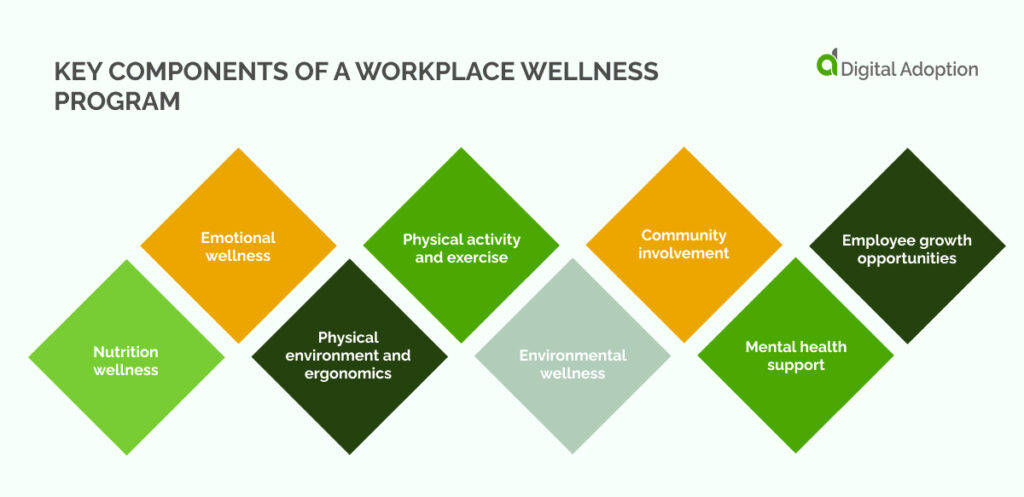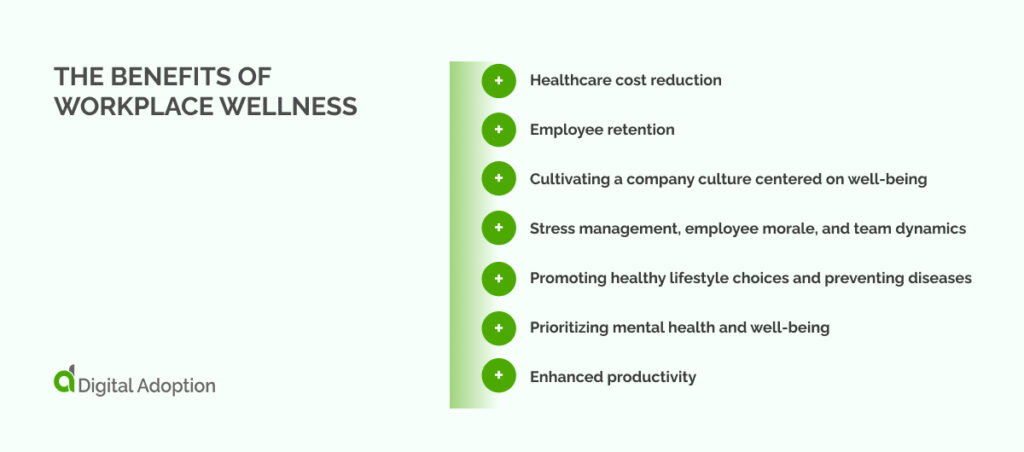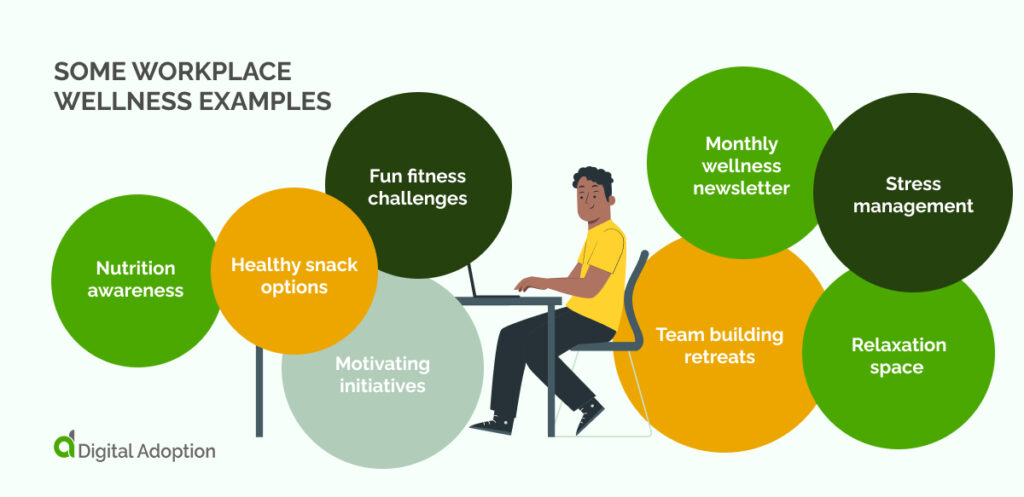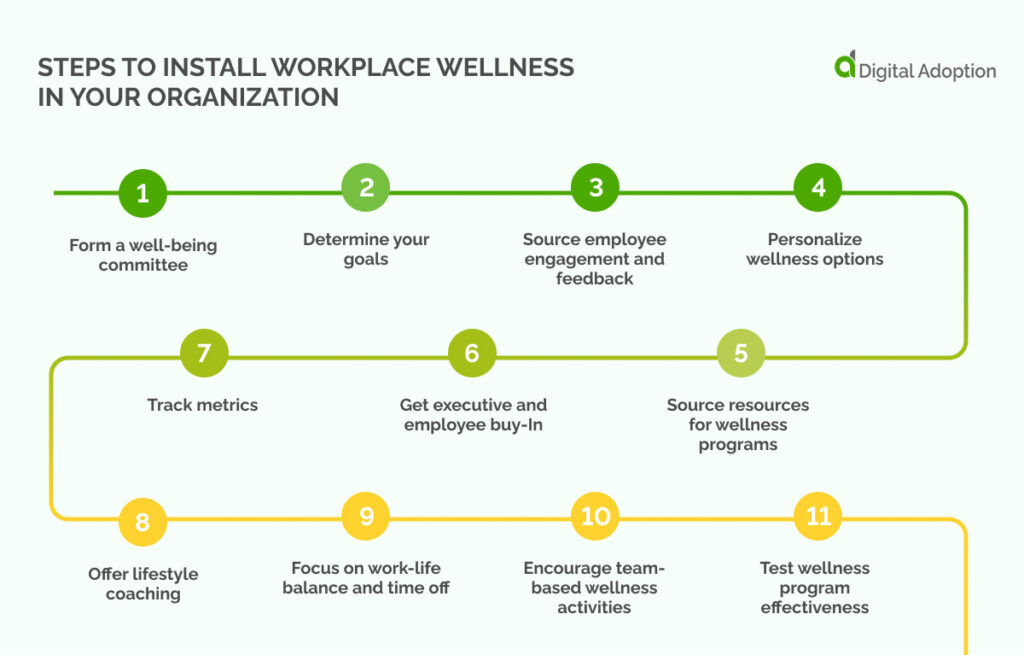In the past, workplace wellness focused on mental and physical health. Today, it includes financial, social, emotional, physical, environmental, and mental health.
There’s no universal definition for workplace wellness programs. So, any initiative that promotes employee experience is part of a workplace wellness program. The most effective workplace wellness programs are genuine. They focus on various dimensions of wellness and promote a culture of wellness. This approach goes beyond concentrating on traditional healthcare benefits.
This guide will focus on workplace wellness and why it is vital. Next, we will examine the main components of a workplace wellness program. Then, we will examine the benefits of workplace wellness and some examples of what this looks like. Finally, we will examine how you can improve workplace wellness efforts.
What is workplace wellness?
Workplace wellness encompasses activities and programs designed to enhance employee health and well-being. These initiatives help employees manage stress, build relationships, boost productivity, and reduce burnout.
Supporting employees in this way can lead to better work performance. Wellness programs can also improve employee engagement. They can also decrease turnover. To be effective, workplace wellness programs should identify what employees need.
Why is workplace wellness important?
Workplace wellness is important as healthy employees generally incur lower healthcare costs. Employees should feel happier and valued at work. They can then exhibit a stronger commitment to the company’s mission.
Addressing employee wellness also enhances public health. Moreover, well-supported employees experience reduced stress, better sleep, and job manageability.
Healthier employees take fewer sick days. Workplace wellness also improves a company’s ability to attract and keep talent.
Key components of a workplace wellness program

The main components of a workplace wellness program are:
Nutrition wellness
It is crucial to include nutrition as a fundamental part of any workplace wellness program. Employers can integrate practical strategies into the work environment, offer educational resources on nutrition, provide workshops or seminars, and provide access to healthy food options.
Emotional wellness
Emotional wellness involves acknowledging, understanding, and expressing emotions. It’s about managing emotional responses. It also includes nurturing relationships and maintaining self-esteem and resilience. It’s not constant happiness but rather a balanced emotional state.
Physical environment and ergonomics
Employee wellness begins in the physical environment. Ergonomic workstations, proper lighting, and vision protection should be standard workplace health features.
Physical activity and exercise
Effective workplace wellness programs promote increased physical activity to improve employee health. They aim to reduce stress levels and enhance job satisfaction. Encouraging step goals and basic exercise routines can help employees become more active.
Environmental wellness
Environmental wellness involves a healthy relationship with surroundings beyond recycling. It requires actions that protect Earth’s resources and surroundings. This encourages sustainable practices and environmental responsibility.
Community involvement
Encouraging employees to donate time to causes they care about supports their well-being. You could do this by creating an annual calendar with company-wide giving-back opportunities.
Mental health support
One associates poor mental health with employee turnover, productivity loss, absenteeism, and presenteeism. Companies may provide effective stress management techniques such as mindfulness and relaxation strategies. Offering perks like childcare support can also help reduce stress.
Employee growth opportunities
Supporting employee growth includes education, employee training, and clear advancement paths. This involves career development through mentoring, coaching, performance management, and skills use.
Continuous learning opportunities, mid-career reviews, and vocational learning contribute to employee development.
Employers can offer classes and seminars to educate employees on financial health. Matching contributions to retirement plans can further support financial well-being.
Innovation workshops can further enhance collaboration and innovation within the company.
What are the benefits of workplace wellness?

Workplace wellness programs offer a variety of benefits, such as:
Healthcare cost reduction
Employees with conditions like obesity and diabetes often lead to increased healthcare costs. Implementing employee well-being platforms can reduce operational costs.
These platforms encourage employees to take part in health assessments. Rewards for making healthier lifestyle choices can reduce healthcare expenses. This approach also boosts productivity and employee well-being.
Employee retention
Onboarding new employees is time-consuming and expensive. Retaining existing employees is crucial for company stability and growth. Offering benefits and a workplace wellness program gives employees a reason to stay.
Executive support for employee well-being is also important. This signals that the company is a great place to work.
Cultivating a company culture centered on well-being
Employee wellness commitment indicates a company’s dedication to creating a healthy work environment. Over time, this approach becomes an integral part of the company’s culture. It influences how employees perceive and engage with their workplace.
Employee engagement extends beyond health screenings and group activities. Wellness programs that include activities like team-based games create a sense of belonging. This sense of community strengthens engagement and improves employee retention rates.
Stress management, employee morale, and team dynamics
Effective stress management is crucial for maintaining high employee morale and well-being levels. It can lead to lower absenteeism rates and employee frustration. A positive work environment fosters better relationships among teammates. This contributes to the success of collaborative projects.
Promoting healthy lifestyle choices and preventing diseases
Wellness initiatives play a vital role in promoting healthier lifestyle choices among employees. Companies can reduce these risks through better nutritional habits and regular physical activity. This contributes to a more vibrant and productive workforce.
Prioritizing mental health and well-being
Wellness programs that prioritize mental health can provide employees with valuable resources. These include support for managing stress and maintaining a healthy work-life balance.
This also leads to increased job satisfaction and a stronger sense of connection.
Enhanced productivity
Wellness programs that include mindfulness training make it easier to cope with stress.
These programs reduce stress levels, improving employees’ decision-making abilities and concentration. Then, companies have more productive and resilient teams capable of handling challenges.
What are some workplace wellness examples?

Some examples of workplace wellness initiatives include:
- Nutrition awareness: Host theme days where employees can cook healthy recipes. You could put ‘Meat-Free Monday’ in place to further promote nutrition awareness.
- Healthy snack options: Introduce vending machines stocked with wholesome snacks. Offer sugar-free cafeteria choices and decaffeinated coffee. Provide discounts on healthy foods to encourage healthier eating habits.
- Fun fitness challenges: Design challenges that foster healthy competition in the office. Engaging employees in these challenges can improve signups for wellness screenings.
- Motivating initiatives: Implement 30-day weight loss challenges and step competitions. Reward employees for their efforts to spark motivation and participation.
- Wellness scoreboard: Create a scoreboard that awards more points for physical activities. Include spontaneous challenges like healthier snack choices to drive participation further.
- Monthly wellness newsletter: Maintain accessibility to wellness resources through a monthly newsletter. Feature links to videos, articles, and updates on upcoming challenges and events.
- Stress management: Offer yoga and meditation sessions. These can be effective tools for reducing stress and improving mental well-being.
- Counseling resources: Provide access to counseling resources and support hotlines. This ensures that employees have ongoing support when needed.
- Support groups: Ease stress management through support groups. Sharing experiences in these groups can enhance empathy and normalize struggles.
- Relaxation space: Choose a dedicated space where employees can unwind without discussing work. This space fosters relaxation and mental rejuvenation.
- Team building retreats: Organize retreats to rejuvenate employees and foster team building. These activities align with promoting a healthy work-life balance.
- Personal finance education: Host lunch-and-learn events focused on personal finance management. This supports employees who may need help with money management skills.
- Investment opportunities: Sponsor portfolio reviews to educate your team on wise investment strategies. This helps them prepare for the future.
- Gratitude sharing: Encourage daily gratitude sharing through Google Sheets or office gratitude jars. This practice promotes positivity.
Steps to install workplace wellness in your organization

Here are some steps you can take to put in place your workplace wellness program:
Form a well-being committee
Select a dedicated group of employees who are passionate about well-being. These individuals will serve as change management champions. They will take the lead in developing and implementing a comprehensive wellness program. You can shape this to the specific needs and preferences of your organization.
Determine your goals
Collaborate with your committee members to establish objectives for your program. For instance, if employees aim to enhance their physical health, set specific goals. These could include employees participating in an initial wellness screening. It could also include the number of employees joining a wellness challenge.
You could also set regular monthly fitness challenges. The rewards could include further annual leave days or a dinner for two vouchers. Set goals for each wellness initiative in your program to track your success.
Source employee engagement and feedback
Encourage an employee feedback loop to gather feedback about workplace improvements. By supporting employees to make decisions, you can make them feel valued. You can also tap into their creativity and insights.
For example, employees might express a desire to enhance communication among teams. This employee feedback can guide initiatives aimed at improving workplace relations and collaboration.
Personalize wellness options
Recognize that one-size-fits-all approaches may not meet the diverse needs of your workforce. Consider offering personalized wellness options alongside team-based initiatives. This could include access to 24/7 nurse advice lines. This can offer employees convenient and confidential avenues to address wellbeing concerns.
Source resources for wellness programs
Build a comprehensive wellness program by offering resources catering to different aspects of well-being. This could include fitness classes, nutritional guidance, and stress management resources. This ensures you can create a program that resonates with a broad range of employees.
Get executive and employee buy-In
Secure buy-in from leadership and employees to ensure a successful wellness program. Use data-driven success stories to show the business impact of your wellness initiatives. Tracking key metrics related to wellness can provide insights for future program enhancements.
Track metrics
Track a range of metrics to check the effectiveness of your wellness program. This may include participation rates broken down by demographic data. It can also include employee satisfaction surveys and employee stress and anxiety levels.
Offer lifestyle coaching
Introduce lifestyle coaching to help employees navigate work-related and personal challenges. Coaches can offer personalized guidance on managing various issues. These include sleep deprivation, stress, unhealthy habits, and work-life balance. In this way, you can empower employees to make positive changes.
Focus on work-life balance and time off
Offering good vacation and time-off policies can promote a better work-life balance. Managers should also be encouraged to assess and adjust workloads to ensure they are manageable. This proactive approach can help reduce stress, prevent burnout, and improve employee well-being.
Encourage team-based wellness activities
Organizing group activities centered around wellness fosters team bonding and solidarity. Activities could involve participating in wellness challenges or joining group exercise classes. They improve morale and strengthen relationships among team members.
Test wellness program effectiveness
Monitor and check the effectiveness of your wellness program. Do this to identify areas for improvement and ensure optimal resource allocation. Analyzing engagement data can offer valuable insights into what’s working well. Feedback from employees can also help. Use this information to maximize its impact on employee well-being and organizational success.
Key takeaways for workplace wellness
Workplace wellness programs foster a supportive environment that promotes healthy behaviors. This enables employees to thrive and impacts various aspects of business performance. It enhances employee performance, satisfaction, morale, and collaboration.
Simply offering a wellness program isn’t enough. Understanding employee behaviors and motivations is crucial. You also need to adapt workplace wellness programs to changing business dynamics. These include the rise in remote work due to the COVID-19 pandemic.
It’s vital to recognize that not all employers need the same support. Taking meaningful steps to understand each employee’s well-being needs is key. This guide can assist you in implementing a successful workplace wellness program. This one cultivates a productive, motivated, and well-cared-for workforce.
Additionally, workplace wellness goes beyond programs. It involves building a crafted culture of well-being. In this culture, every member of the organization plays a role. They contribute not only to their own wellness but also to support their colleagues.
Addressing these components of workplace wellness helps establish a productive work environment. Continuously test your wellness program. This ensures you’re meeting all elements that benefit both employees and the company.













